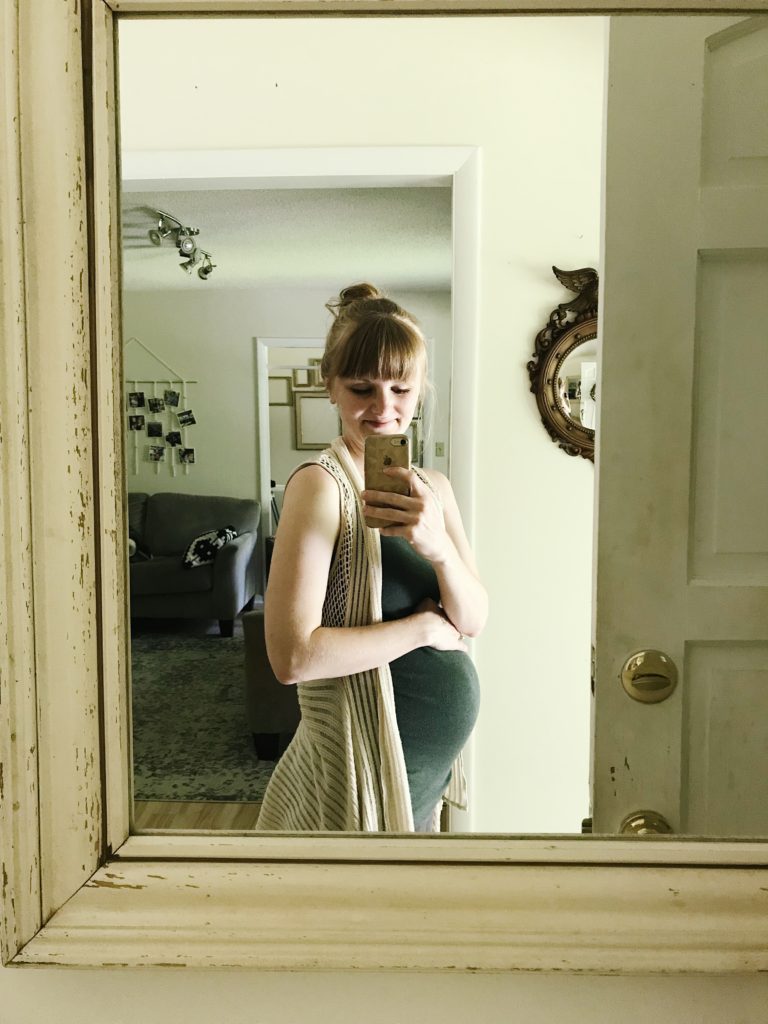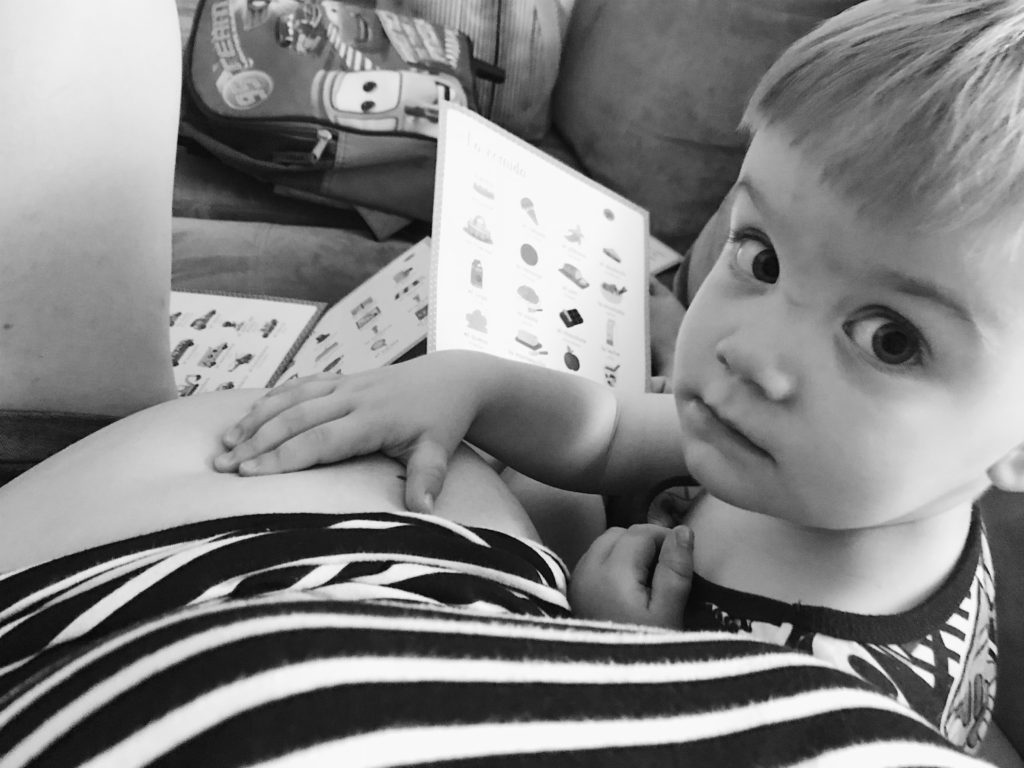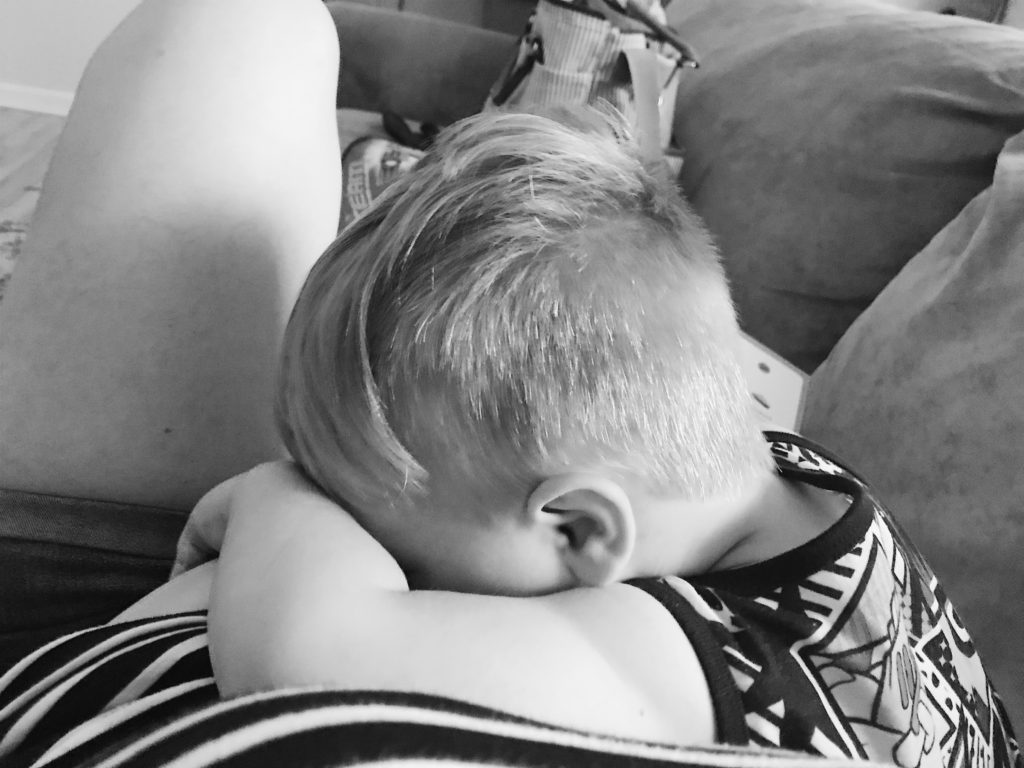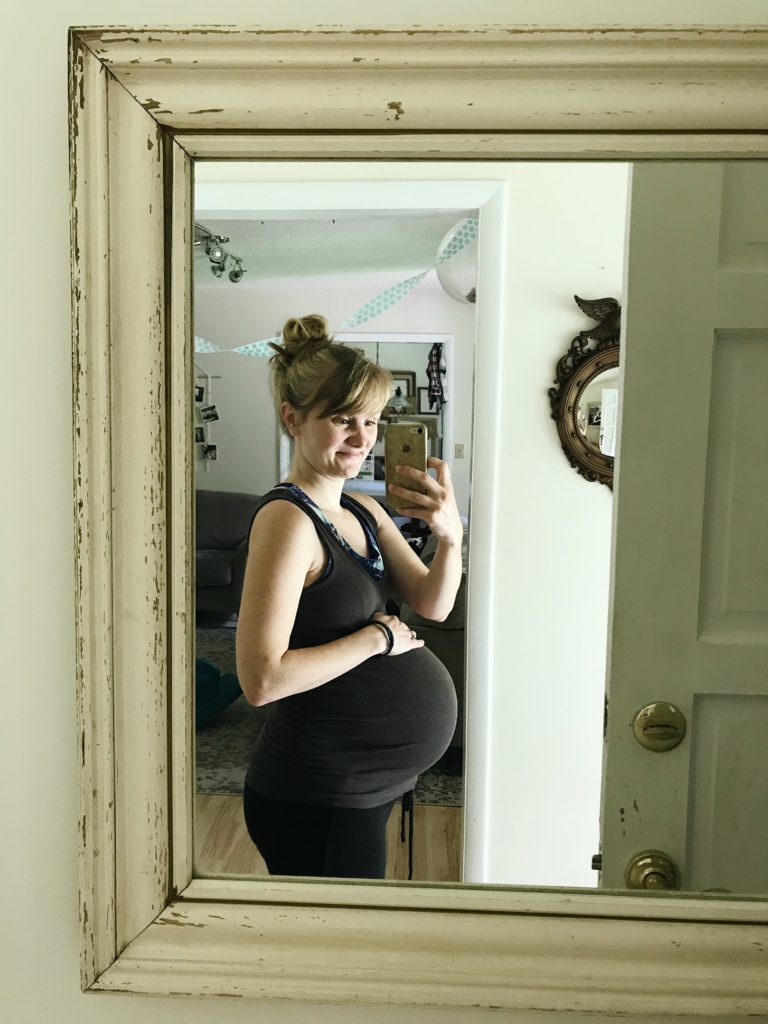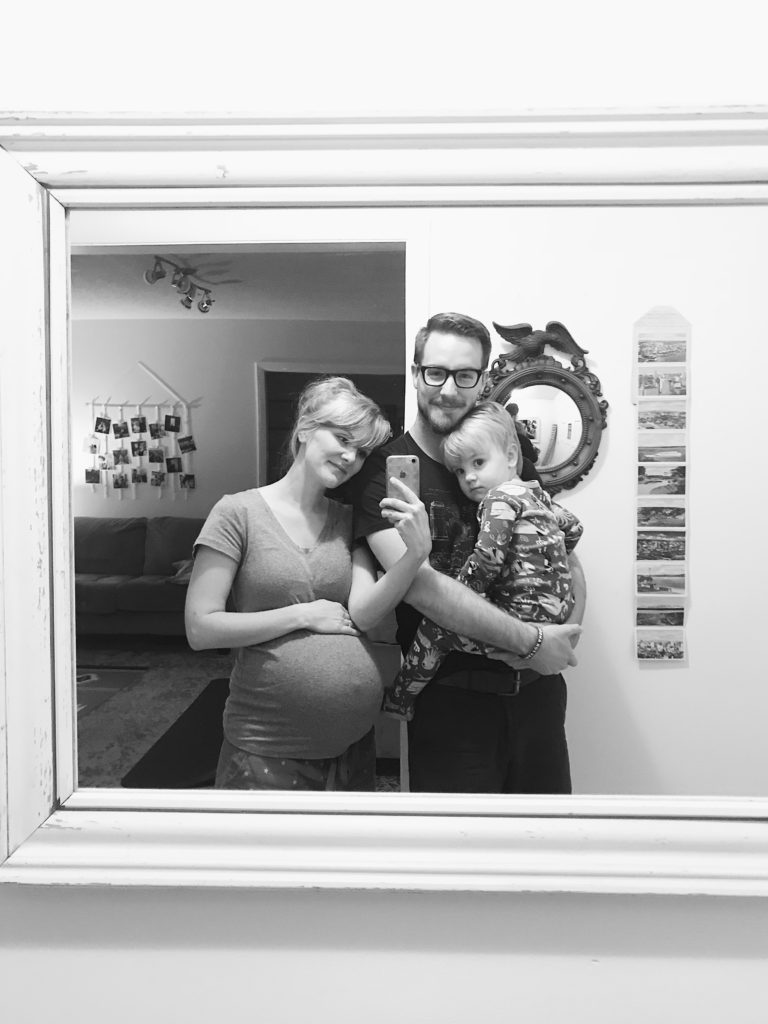If you haven’t yet read the introduction to Emmeline’s story, feel free to start there.
I mentioned this yesterday, but just a reminder if you missed it – if pregnancy stories are tough for you to read, or triggering for any reason at all, please be kind to yourself. There is no reason at all for you to read this story if it isn’t helpful for you. Although it is a positive birth story in my eyes, it does include a very fast labor, a call to 911, and a birth at home.
I’ve also included affiliate links in this post for The Birth Hour’s Know Your Options Childbirth Course. If you sign up via my link I’ll get a kickback at no additional cost to you. I so appreciate your support!
With this pregnancy I felt a lot more pregnant, from beginning to end. Not in a bad way – just that everything was more. I felt a lot more nauseous during my first trimester, and for more weeks than with Beckett. I felt more movement from baby since my placenta was posterior this time (with Beckett it was anterior, or in front, which is said to cushion some of baby’s kicks). I had a LOT more Braxton Hicks contractions, starting around 20 weeks and going throughout the rest of my pregnancy. I also felt a lot more pressure down low as the pregnancy went on. Dr Sal was wonderfully reassuring about all of this, reminding me that it’s completely normal to feel more of everything with subsequent pregnancies.
The only “complications” were simple ones that didn’t actually affect our pregnancy (thanks modern medicine) and they were the same ones we dealt with when I was pregnant with Beckett. I get “benign gestational thrombocytopenia” when I’m pregnant (which is low platelets and can affect whether I’m a candidate for an epidural if they drop too low before delivery – they stayed just high enough both times that I could have gotten an epidural if I wanted one). I also tend to have low iron during pregnancy, like many women. And my blood is Rh-negative, so I have to get the Rhogam shot during and after pregnancy to protect myself and future babies from potential complications.
We decided not to find out whether we were having a boy or girl, just like with our first pregnancy. That’s a decision Tim and I made together before we ever started trying to have babies. We both thought it would be such a special experience to find out together when we meet our little one in the delivery room. We loved doing that with Beckett and we wanted to do the same this time around. If I had guessed what we were having during my first trimester I would have guessed girl – with all the extra nausea and how much I craved sweets during that time, it felt different from my first pregnancy.
Once I made it past the first 14 or 16 weeks I finally started feeling better and from then on out I felt more like we were having a boy. The baby was just as active, if not more so than Beckett was in my belly. To me it felt like another boy because that’s what I knew. Baby’s kicks felt familiar – I could imagine those jabs to my ribs being another active little boy – a little brother to Beckett. But then some days I wondered if it could be a little girl – maybe just an active wiggly baby girl in my belly? I went back and forth almost daily. I was probably 60/40 between boy and girl, leaning slightly more toward boy since that’s what was familiar.
I really cherished the time as my belly grew bigger and Beckett started to understand what was happening. Some days I would think he didn’t get it at all, but then he would surprise me and ask to kiss the baby, wrapping his arms around my belly and planting a kiss on my round tummy. Since he came with us to nearly every appointment, he loved pretending to listen to the baby’s heartbeat. Sometimes, without warning, he would lift my shirt up over my belly and gently place his fist on my belly while making a “shh shhh, shh shhh” noise to imitate listening to the baby’s heartbeat with the doppler.
After working my way through the modules of the Know Your Options course, I realized there were a few things I would have done differently or at least known to ask more questions about during my first labor and delivery with Beckett. Looking back, a theme of that labor for me was the feeling of being sort of immobile – I remember feeling trapped to the bed, trapped to the monitors strapped around my belly, and trapped to the IV fluids my nurse insisted I have when I arrived in labor. Every time I needed to get up and go to the bathroom, I had to be unhooked from all the things and I felt like such a nuisance asking my nurse to come in and help me with all those things so I could just get up to pee. (I know, I know, that’s what they’re there for – but I have such high empathy that I never want to bother anyone even if it’s their job! Plus, the first nurse I had that night wasn’t particularly warm and fuzzy, and we didn’t really connect, so that made it more difficult for me to feel like I could ask for what I needed.)
During this pregnancy I learned more about standard procedures in L&D, what you can request while in labor, that sort of thing. I learned about intermittent monitoring and wireless monitoring and knew that since having Beckett, our hospital had acquired more wireless monitoring equipment, so it was more likely I’d be able to ask for that this time around. I knew feeling more mobile would certainly help my mindset while in labor. I had also hated the feeling of having a saline lock, or hep-lock, in my hand – I’m not a huge fan of needles, so just thinking about it made me uncomfortable. I figured it was standard procedure for every laboring woman to get a hep-lock when they arrive – it makes it easy to administer fluids and meds as needed. But as I learned more, I began to question whether or not I had needed the bag of fluids while I was in labor with Beckett. I don’t remember my nurse ever explaining why I needed them (I’m sure she probably told me it was standard, but I have no recollection of it.)
I learned this time around that getting fluids is a prerequisite to getting an epidural. But I hadn’t asked for an epidural and I had told my nurse I wanted to go without if at all possible. Having those fluids when I first arrived to the hospital in labor with Beckett certainly didn’t hurt anything. But being trapped in the bed while I waited for the bag to drain felt agonizing. I remember feeling frustrated and mentally drained when my nurse came back in maybe a half an hour after starting the fluids and I pointed out that the bag didn’t seem to be draining. She sort of frowned and unhooked and rehooked everything up and the bag drained in seemingly no time at all, much to my relief. After that I was told I could get out of bed and labor how I wanted.
Our hospital opened a new women’s wing shortly after Beckett was born, so we decided to do another hospital tour to familiarize ourselves with where we’d be delivering and ask any questions we might have. At the end of the tour I asked our guide if it was standard procedure for every laboring mama to get a hep-lock upon arrival (even though I thought I knew the answer). When she answered yes I asked about the bag of fluids and whether that was standard as well. She told me I’d need one if I wanted an epidural but otherwise could decline.
I double checked with Dr Sal at my next appointment, recalling my labor with Beckett and how I’d felt so trapped while waiting to get the fluids. She gave me a funny look and asked, “But your nurse knew you didn’t want an epidural, right?” I nodded and told her how I’d relayed our “birth plan” to our nurse upon arrival and Dr Sal sort of laughed and said something like, “She didn’t think you could do it! She must have thought ‘oh, first time mom, uh huh, sure you don’t want an epidural…’ and decided it was better to go ahead and give them to you instead.” It’s a little prideful but I felt SO validated by Dr Sal’s words! It was encouraging to hear from her that I certainly could turn fluids down, while keeping in mind that I would have to get them if I changed my mind and wanted an epidural.
Toward the end of my pregnancy when Dr Sal started checking for baby’s position he/she was always head-down and low in my pelvis. So we knew we had a cooperative, but still very wiggly baby. During my final few appointments I opted not to “get checked” for how dilated I was – I knew that number really didn’t mean a whole lot before labor gets going. With Beckett I wasn’t dilated at all the day before I went into labor and I felt SO discouraged when I found out, but I’ve also heard stories of moms who walk around a few centimeters dilated for the last few weeks of their pregnancies and it doesn’t necessarily mean labor is imminent. I decided I didn’t need to know the number because it would probably just serve to mess with my mind and either discourage me or put me on edge.
The weekend before our due date Hurricane Florence was aiming straight for the North Carolina coast. Our doctor reminded us to make sure we had our hospital bags packed as big storms like this one tend to fill up the delivery wings at hospitals. I’m not sure if there are any official studies that have been done but I read there’s something about the change in barometric pressure that can get labor moving!
That week as the hurricane was aiming for our coast, The Birth Hour released a podcast titled 911 Call Roadside Delivery Birth. Sort of as a joke, I decided to listen to it “just in case” our baby decided to make his or her entrance during the hurricane, and just in case any roads were closed between our house and the hospital, and just in case baby arrived quickly while we were on the road or something crazy. I even had Tim listen to the podcast, you know, just in case.
Alas. We made it through the entire hurricane unscathed – apart from a ton of rain and a huge tree that fell in our front yard. Baby was happy to stay put through the storm and we were so grateful.
As our due date was approaching I remember sort of mourning the end of this season with just Beckett being my only little buddy. I remember knowing things were about to change big time, especially the amount of time and attention I’d be able to devote to him and I was certain it would feel like a big transition for him.
The night before I went into labor I had the sweetest time saying goodnight to Beckett. He laid on my shoulder longer than usual, we prayed together as a family like we try to do every night, and he let me rock him for a few minutes before gently leaning out of my arms to be put down in his crib. He’d been having some more difficult bedtimes as of late, but that evening was different. Just sweet and snuggly.
Tim and I spent some sweet time together that evening too as we dreamt of what was to come – what this next season might bring. I journaled for a while, reflecting on the transition to come, on the sweet bedtime with Beckett, and musing about how many more nights I would put him to bed as an only child.
I remember standing in the shower before bed that night, hand on my belly, feeling like, and knowing that it was almost time. I remember looking down and quietly saying to my belly “okay baby, you can come any time now,” having no idea she’d be in my arms 8-9 hours later.
Click through to the next post about Emmeline’s actual birth day and to hear our 911 call.
